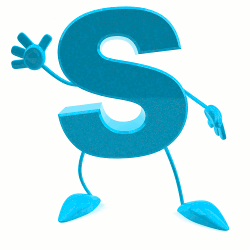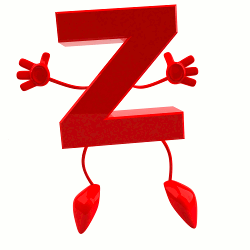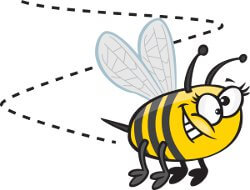S and Z Sounds
s:(sit, box, cats)
z:(zip, buzz, boys)
English Pronunciation, Lesson 25
The S and Z sounds are often studied as a pair because they sound very similar, and both sounds are made in the same part of the mouth. There are some differences. The S sound is voiceless, and the Z sound is voiced. What does all of this mean? Read on to find out.
Click Here for Step-by-Step Rules, Stories and Exercises to Practice All English Tenses
How to pronounce the S and Z sounds
The voiceless (unvoiced)
S
sound
(IPA
symbol: s
The voiced Z sound (IPA symbol: z) can be found in English words such as zip, exist, buzz, boys, his, was, and is.

Both of these sounds are produced in the front part of your mouth. When you make these sounds, your lips will be slightly open. Your teeth should lightly touch in the front or be very close together. The front of your tongue will touch the back of your lower teeth. The back of your tongue touches the roof of your mouth on the sides.
When making the S and Z sounds, air is pushed down the center of your tongue and between the tip of your tongue and your top teeth. The movement of the air makes the S and Z sounds.


In this video, Rachel from Rachel's English will show you how to position your mouth to make each of these sounds.
Voiced and voiceless sounds
In the English language, we use many voiced sounds. That means that the vocal cords vibrate when you say that sound. The Z sound is a voiced sound because the vocal cords vibrate when you make the sound.The S sound is a voiceless or unvoiced sound because the vocal cords do not vibrate when you make the sound. Instead, we use air to make the sound.
Spellings
There are five common spellings of the S sound: s/ss, ce, ci, sc, and x.There are three common spellings of the Z sound: z/zz, s, x.
Let's look at a few rules for some of the common spellings.
- s spelling (sit,
wise, dogs, cats)
The s spelling is sometimes pronounced as an S sound (sit, cats) and sometimes as a Z sound (wise, dogs)
It is more likely to be pronounced as a Z sound if it comes between two vowel sounds: wise, visit, busy.
There are not many rules to help us know which sound is used, so it is very important to learn the correct pronunciation of each new word.
- sc spelling
(science, descend, score)
The sc spelling can be pronounced as an S sound alone or as an S + K sound. It is more likely to be pronounced as an S sound when it comes in the middle of a word, but not all words follow the rule.
S sound = muscle, descend, science
S + K sound = scream, score, scare
- x spelling
(fox, exist)
The x spelling can be pronounced in two different ways:
K + S sound = fix, fox, next
G + Z sound = example, exist
*Note: "Exit" can be pronounced as an K + S sound or G + Z sound. Either way is accepted.
Learn or review the K and G sounds here: English Pronunciation Lesson 26 - K and G Sounds.
It can be hard to know how to pronounce new words. You can use a dictionary or online pronunciation guide to help you learn the correct pronunciation of new vocabulary words.
Let's practice
Practice the
voiceless S soundPractice the voiceless S sound by saying these words:
- say
- sad
- so
- sits
- sound

- sister
- its
- cats
- cross
- miss
- boss
- this
- lips
- misty
- face
- practice
- bounce
- mouse
- house
- mice
- box
- fox
- science
- city
- circle
- fence
- scare
(s + k sound)
- score
(s + k sound)
- Saturday
- Sunday
Now, let's practice the voiced Z sound. Remember, your vocal cords should vibrate when you make this sound because it is a voiced sound.
- zip
- zoo
- zap
- zebra
- quiz
- buzz
- freeze

- dozen
- is
- was
- his
- hers
- nose
- noise
- noises
- rose
- roses
- bags
- frogs
- boys
- girls
- friends
- lies
- busy
- noisy
- nosy
- exist
- Tuesday
- Wednesday
- Thursday
Remember to voice the Z sound and use only air for the S sound!
| Z | S |
| is |
its |
| exist | fox |
| zag | sag |
| boys | cats |
| Tuesday | Sunday |
Challenge words!
These are more challenging words. Some of these words even have both sounds! Practice them slowly.
The S sounds are in blue. The Z sounds are in green.
- sizes
- sounds
- science
- business

- freezers
- zippers
- scientists
- noisiest
- because
- anxiety
- quizzes
- descend
- oxygen
- license
Now say these sentences out loud.
The S sounds are in blue. The Z sounds are in green:
1) Is Sally his sister?
2) Sam was my son.
3) The seven dogs and cats stay inside the house.
4) He was so sad last Sunday.
5) The sun is so high in the sky.
6) Six boys and girls sat on the fence outside the store.
7) The science quiz was easy.
8) Please sit beside your friends.
9) Is this house hers?
10) CHALLENGE:
The seven students took the first test for their driver's licenses on the last Thursday in December.
Remember to practice these two sounds together, so you can learn their differences! Practice them slowly to hear how they sound.
Let's move on...
List of Lessons
Lesson 01: International
Phonetic Alphabet (IPA)
Lesson 02: Word
Stress and Syllables
Lesson 03: Long E
sound (meet,
see)
Lesson 04: Short I
Sound (sit,
hit)
Lesson 05: UH Sound
(put, foot)
Lesson 06:
OO Sound (moon,
blue)
Lesson 07: Short E
sound (pen, bed)
Lesson 08: Schwa
Sound (the, about)
Lesson 09: UR Sound (turn, learn)
Lesson 10: OH Sound (four, store)
Lesson 11: Short A
Sound (cat, fat)
Lesson 12: UH Sound (but, luck)
Lesson 13: Soft A
Sound (arm, father)
Lesson 14: Long O
Sound (boat,
know)
Lesson 15: Long A
Sound (say, pain, make)
Lesson 16: Short O
Sound (not, off, socks)
Lesson 17: Diphthong
(a combination of two vowel sounds)
Lesson 18: P Sound
(cup, punch, pull) and B sound (cub, bunch, bull)
Lesson 19: The Nasal
Sounds (M, N, NG)
Lesson 20: F Sound (four, lift, graph, tough) and V Sound (love, knives, grave, vine)
Lesson 21: W Sound (wow, quit, where)
Lesson 22: R Sound (red, sorry, write)
Lesson 23: H Sound (he, behind, who)
Lesson 24: T Sound (top, it, later) and D Sound (do, had, made)
Lesson 25: S Sound (sit, box, cats) and Z Sound (zip, buzz, boys)
Lesson 26: K Sound (kid, talk, black) and G Sound (go, big, dog)
Lesson 27: L Sound:
Light L & Dark L (tall,
like, English)
Lesson 28: Y
Consonant Sound (yes,
you, beyond)
Lesson 29: CH Sound (China, century, watch) and J Sound (Germany, educate , judge)
Lesson 30: TH
Consonant Sounds – voiced TH sound (the,
father, them) and voiceless
(unvoiced) TH sound (think,
birthday, south)
Lesson 31: SH
(shop, chef, special) and ZH (usual, massage, Asia)
Lesson 32: T and TT Sounds (true T sound, D sound, stop sound, silent T)
Get Updates, Special Offers, and English Resources
Download your FREE GIFT (the first two chapters of
English Short Stories Book and Workbook)
as soon as you join!

By submitting your email, you consent to receiving updates and newsletters from us and to the sharing of your personal data with third parties for the purposes of sending you communications. We will not spam you. You can unsubscribe at any time. For more information, please see our privacy policy.





